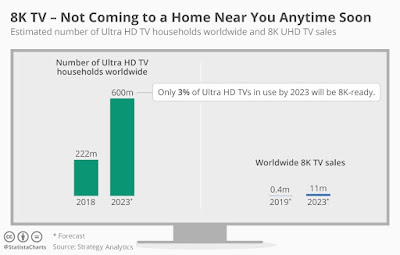H.266
codec to reduce video sizes by 50%
A new video encoding standard that reduces video file sizes
by 50% is set to become usable by the end of the year, allowing high-resolution
footage to be saved with smaller file sizes and to be transmitted in less time.
Versatile Video Coding (h.266/VVC) is the newest block-based hybrid codec from
the Joint Video Experts Team (JVET), a group comprised of MPEG and ISO/ITU
members such as Bitmovin and Fraunhofer HHI, and promises to vastly improve the
compression capabilities of workflows for any organization within the streaming
industry, including but not limited to, OTT, VR, AR, and many other providers.
As fellow members of MPEG, the Bitmovin encoding team was eager to test the
capabilities of the newest codec and the potential improvements it offered over
its predecessor h.265/HEVC. The ultimate goal of the project was to determine the
performance parameters of the VVC codec and the subjective visual quality
enhancements that ensue. While Fraunhofer HHI claimed that the VVC codec
promises to improve visual quality and reduce bitrate expenditure by around 50%
over HEVC, we wanted to prove the validity of the statement.

Today, compressed video data make up 80% of global
Internet traffic. H.266/VVC represents the pinnacle of (at least) four
generations of international standards for video coding. The previous standards
H.264/Advanced Video Coding (AVC) and H.265/HEVC, which were produced with
substantial contributions from Fraunhofer HHI, remain active in more than 10
billion end devices, processing over 90% of the total global volume of video
bits. Both previous standards were also recognized by collectively three Emmy
Engineering Awards for contributing substantially to the progress of television
technology.

Through a reduction of data requirements, H.266/VVC makes
video transmission in mobile networks (where data capacity is limited) more
efficient. For instance, the previous standard H.265/HEVC requires ca. 10
gigabytes of data to transmit a 90-min UHD video. With this new technology,
only 5 gigabytes of data are required to achieve the same quality. Because H.266/VVC
was developed with ultra-high-resolution video content in mind, the new
standard is particularly beneficial when streaming 4K or 8K videos on a flat
screen TV. Furthermore, H.266/VVC is ideal for all types of moving images: from
high-resolution 360° video panoramas to screen sharing contents.

The
new H.266 standard will also allow systems or locations with poor data rates to
receive larger files more quickly, so movies, for example, will buffer less and
play more smoothly. Mobile devices will also be able to send higher resolution
files, or longer clips, without using so much data.
Fraunhofer
says that ‘H.266/VVC offers faster video transmission for equal perceptual
quality,’ so we shouldn’t see the difference between files compressed by H.266
and those compressed using H.265. H.265 also halved file sizes when it was
introduced, as did the H.264 standard that came before that — and which is
still in use today.
The
new standard requires new chips to make the most of it, and the press release
states that they are already in production and that Fraunhofer will release the
software to allow the standard to be used in the autumn of this year.
Another
factor hindering the evolution of an 8K ecosystem is the question of cable and
broadcast support. At the moment, the broadcast industry is beginning to deploy
ATSC 3.0 (Advanced Television Systems Committee/ also known by the
moniker Next Gen TV, establishes an IP-based broadcast transmission system), a
major revision to the Advanced Television Systems Committee. ATSC 3.0 supports
features like 4K broadcasting, wide color gamuts, and HDR. The standard,
however, is not targeting 8K and the rollout is optional. Unlike the mandatory
transition from NTSC to ATSC, ATSC 3.0 deployment is up to individual
companies. There’s no mandate to include an ATSC 3.0 tuner inside a TV, for
example.
Also,
ATSC 3.0 contains some features that “improve” targeted advertising. So hurrah
for that.
At
any rate, the rollout of ATSC 3.0 is going to be the major focus for
broadcasters. It’s not clear which codecs will be used — there are a number of
articles diving into why H.265 adoption has been so slow compared with H.264.
It’s possible that the bandwidth improvements from H.264 to H.266 might be big
enough to be enticing — a video that requires 10GB of storage when encoded in
H.264 would theoretically only require 2.5GB when encoded in H.266 with no
(again, theoretical) loss of quality.
Ericsson CTO Erik Ekudden’s view on recent developments in video
compression technology
Continuous innovation in 5G networks is
creating new opportunities for video-enabled services for both consumers and
industries, particularly in areas such as the Internet of Things and the
automotive sector. These new services are expected to rely on continued video
evolution toward 8K resolutions and beyond, and on new strict requirements such
as low end-to-end latency for video delivery.
This Ericsson Technology Review article
explores recent developments in video compression technology and introduces
Versatile Video Coding (VVC) – a significant improvement on existing video
codecs that we think deserves to be widely deployed in the market. VVC has the
potential both to enhance the user experience for existing video services and
offer an appropriate performance level for new media services over 5G networks.




